You plan to deploy an Azure Database for MySQL flexible server named Server1 to the East US Azure region.
You need to implement a business continuity solution for Server1. The solution must minimize downtime in the event of a failover to a paired region.
What should you do?
Answer:
C
You have an Azure subscription that contains a Basic Azure virtual WAN named VirtualWAN1 and the virtual hubs shown in the following table.
You have an ExpressRoute circuit in the US East Azure region.
You need to create an ExpressRoute association to VirtualWAN1.
What should you do first?
Answer:
A
A basic Azure virtual WAN does not support express route. You have to upgrade to standard.
Reference:
https://docs.microsoft.com/en-us/azure/virtual-wan/virtual-wan-about
You have an Azure subscription that contains a storage account.
An application sometimes writes duplicate files to the storage account.
You have a PowerShell script that identifies and deletes duplicate files in the storage account. Currently, the script is run manually after approval from the operations manager.
You need to recommend a serverless solution that performs the following actions:
✑ Runs the script once an hour to identify whether duplicate files exist
✑ Sends an email notification to the operations manager requesting approval to delete the duplicate files
✑ Processes an email response from the operations manager specifying whether the deletion was approved
✑ Runs the script if the deletion was approved
What should you include in the recommendation?
Answer:
B
You can schedule a powershell script with Azure Logic Apps.
When you want to run code that performs a specific job in your logic apps, you can create your own function by using Azure Functions. This service helps you create Node.js, C#, and F# functions so you don't have to build a complete app or infrastructure to run code. You can also call logic apps from inside Azure functions.
Reference:
https://docs.microsoft.com/en-us/azure/logic-apps/logic-apps-azure-functions
Your company has the infrastructure shown in the following table.
The on-premises Active Directory domain syncs with Azure Active Directory (Azure AD).
Server1 runs an application named App1 that uses LDAP queries to verify user identities in the on-premises Active Directory domain.
You plan to migrate Server1 to a virtual machine in Subscription1.
A company security policy states that the virtual machines and services deployed to Subscription1 must be prevented from accessing the on-premises network.
You need to recommend a solution to ensure that App1 continues to function after the migration. The solution must meet the security policy.
What should you include in the recommendation?
Answer:
D
Azure Active Directory Domain Services (Azure AD DS) provides managed domain services such as domain join, group policy, lightweight directory access protocol (LDAP), and Kerberos/NTLM authentication.
Reference:
https://docs.microsoft.com/en-us/azure/active-directory-domain-services/overview
You need to design a solution that will execute custom C# code in response to an event routed to Azure Event Grid. The solution must meet the following requirements:
✑ The executed code must be able to access the private IP address of a Microsoft SQL Server instance that runs on an Azure virtual machine.
✑ Costs must be minimized.
What should you include in the solution?
Answer:
B
Virtual connectivity is included in the Premium plan.
Reference:
https://docs.microsoft.com/en-us/azure/azure-functions/functions-scale#hosting-plans-comparison
You have an on-premises network and an Azure subscription. The on-premises network has several branch offices.
A branch office in Toronto contains a virtual machine named VM1 that is configured as a file server. Users access the shared files on VM1 from all the offices.
You need to recommend a solution to ensure that the users can access the shared files as quickly as possible if the Toronto branch office is inaccessible.
What should you include in the recommendation?
Answer:
D
Use Azure File Sync to centralize your organization's file shares in Azure Files, while keeping the flexibility, performance, and compatibility of an on-premises file server. Azure File Sync transforms Windows Server into a quick cache of your Azure file share.
Reference:
https://docs.microsoft.com/en-us/azure/storage/files/storage-sync-files-deployment-guide
HOTSPOT -
You have an Azure subscription named Subscription1 that is linked to a hybrid Azure Active Directory (Azure AD) tenant.
You have an on-premises datacenter that does NOT have a VPN connection to Subscription1. The datacenter contains a computer named Server1 that has
Microsoft SQL Server 2016 installed. Server is prevented from accessing the internet.
An Azure logic app resource named LogicApp1 requires write access to a database on Server1.
You need to recommend a solution to provide LogicApp1 with the ability to access Server1.
What should you recommend deploying on-premises and in Azure? To answer, select the appropriate options in the answer area.
NOTE: Each correct selection is worth one point.
Hot Area: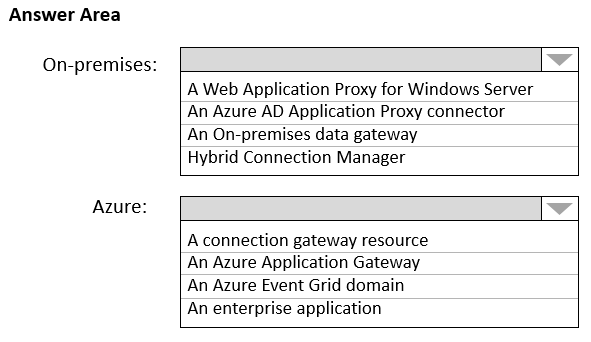
Answer:

Box 1: An on-premises data gateway
For logic apps in global, multi-tenant Azure that connect to on-premises SQL Server, you need to have the on-premises data gateway installed on a local computer and a data gateway resource that's already created in Azure.
Box 2: A connection gateway resource
Reference:
https://docs.microsoft.com/en-us/azure/connectors/connectors-create-api-sqlazure
HOTSPOT -
Your company develops a web service that is deployed to an Azure virtual machine named VM1. The web service allows an API to access real-time data from
VM1.
The current virtual machine deployment is shown in the Deployment exhibit.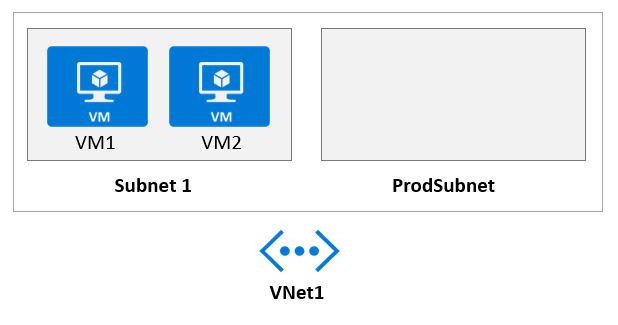
The chief technology officer (CTO) sends you the following email message: "Our developers have deployed the web service to a virtual machine named VM1.
Testing has shown that the API is accessible from VM1 and VM2. Our partners must be able to connect to the API over the Internet. Partners will use this data in applications that they develop."
You deploy an Azure API Management (APIM) service. The relevant API Management configuration is shown in the API exhibit.
For each of the following statements, select Yes if the statement is true. Otherwise, select No.
NOTE: Each correct selection is worth one point.
Hot Area: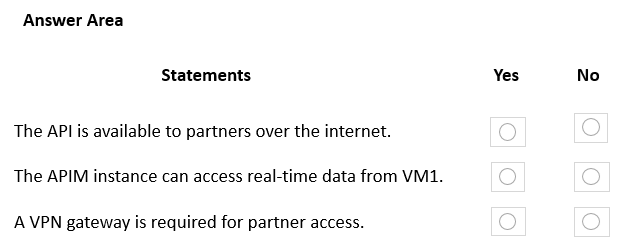
Answer:
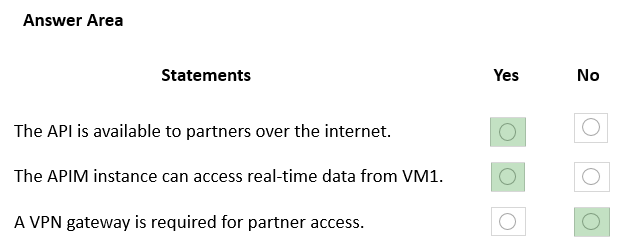
Reference:
https://docs.microsoft.com/en-us/azure/api-management/api-management-using-with-vnet
DRAG DROP -
Your company has an existing web app that runs on Azure virtual machines.
You need to ensure that the app is protected from SQL injection attempts and uses a layer-7 load balancer. The solution must minimize disruptions to the code of the app.
What should you recommend? To answer, drag the appropriate services to the correct targets. Each service may be used once, more than once, or not at all. You may need to drag the split bar between panes or scroll to view content.
NOTE: Each correct selection is worth one point.
Select and Place: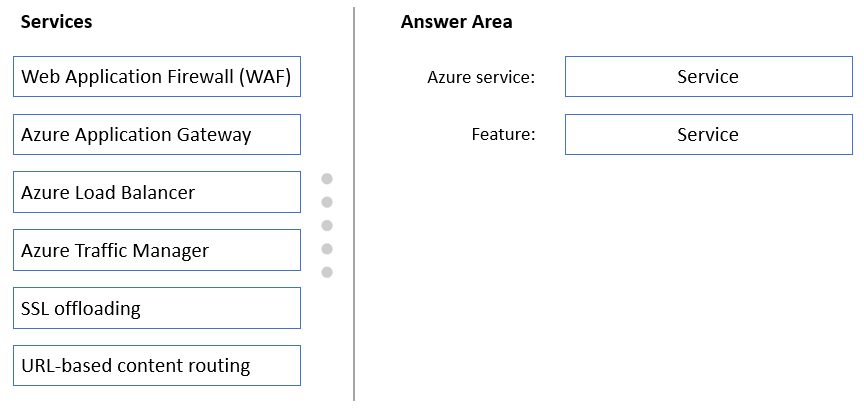
Answer:
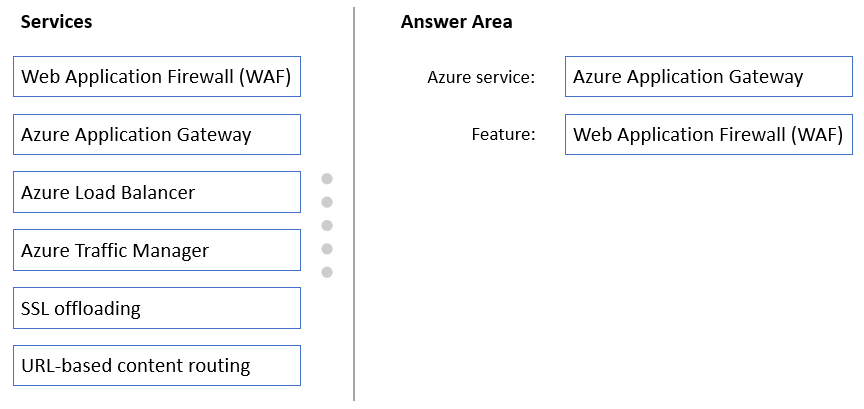
Box 1: Azure Application Gateway
The Azure Application Gateway Web Application Firewall (WAF) provides protection for web applications. These protections are provided by the Open Web
Application Security Project (OWASP) Core Rule Set (CRS).
Box 2: Web Application Firewall (WAF)
Reference:
https://docs.microsoft.com/en-us/azure/web-application-firewall/ag/application-gateway-customize-waf-rules-portal
You are designing a microservices architecture that will be hosted in an Azure Kubernetes Service (AKS) cluster. Apps that will consume the microservices will be hosted on Azure virtual machines. The virtual machines and the AKS cluster will reside on the same virtual network.
You need to design a solution to expose the microservices to the consumer apps. The solution must meet the following requirements:
✑ Ingress access to the microservices must be restricted to a single private IP address and protected by using mutual TLS authentication.
✑ The number of incoming microservice calls must be rate-limited.
✑ Costs must be minimized.
What should you include in the solution?
Answer:
D
One option is to deploy APIM (API Management) inside the cluster VNet.
The AKS cluster and the applications that consume the microservices might reside within the same VNet, hence there is no reason to expose the cluster publicly as all API traffic will remain within the VNet. For these scenarios, you can deploy API Management into the cluster VNet. API Management Premium tier supports
VNet deployment.
Reference:
https://docs.microsoft.com/en-us/azure/api-management/api-management-kubernetes